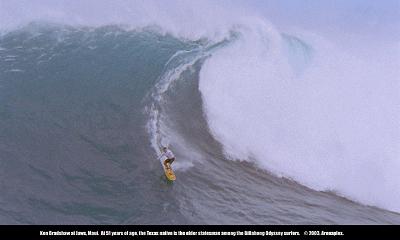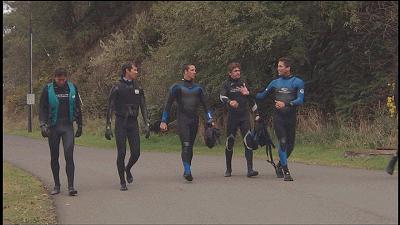

The quest to surf the world's largest wave forms the basis for Billabong Odyssey, a three-year journey featuring the world's best big wave surfer chronicled here for posterity. It's not much of a documentary, and aside from extended shots of interviews would look right at place on a television on the wall of a surf store. In other words, try as hard as it may, there is very little substance here. Also hampering the already thin film is another film, Step Into Liquid, released just a few short months ago. Step Into Liquid is marginally better, and is more of a round-the-world survey of surfing. However, nearly everybody in Billabong Odyssey is in Step Into Liquid, so although it is new, it immediately feels old. Yet another element that hampers this film is that everybody in it is a surfer. There are no filmmakers. The people here can sure surf great, but leave much to be desired when it comes to filmmaking.
There is little focus in director Philip Boston's narrative. Well, there is no narrative. It introduces each of the surfers, gives a little of their history, then zips off to different part of the world. Mike Parsons and Brad Gerlach were old rivals who are now fast friends and hand around. Parsons is the consummate thinker, precise and planned out while Gerlach is spontaneous, and they both hang out Todos Santos, Baja California. Ken Bradshaw is pushing fifty, and still surfing well. Layne Beachley (Blue Crush) is one of a growing number of women making successful inroads into surfing. She only appears here because she is dating Bradshaw. The last group is from Mavericks, Santa Barbara, known for their wild partying habits. Much of the narration is done with voice-over, and with a near complete lack of identification, there is no way to tell who the heck is saying what. This is probably Billabong Odyssey's largest drawback. Moreover, many of these surfers aren't the greatest speakers (nor should they be), and without a capable interviewer, they frequently seem to ramble.
At least Boston focuses on safety. It is impossible to paddle out and surf a big wave, which can get in excess of 50 feet. In order to get close to one, a jet ski must tow a surfer out, providing the necessary speed. Safety is a large priority for all the surfers, so much so that they hired Brian Keaulana as a safety consultant, and a lot of the film deals with Keaulana educating the various surfers on what to do and how to do it. Granted, it's also a chance for everybody to get together and swap stories, but they are deadly serious about staying safe. And considering the appeal that surfing has to teenagers and children, it's great to see these champions of the sport setting a good example.
This finally brings them to the surfing itself. Yes, there are many flaws in Billabong Odyssey, but the main reason people will come to watch this film is to see the surfing footage. It is spectacular. The team made sure to film everything, so there are lots of big waves, lots of successful attempts, and lots of wiping out. Watching Parsons, Gerlach, et al. surf these waves is somewhat misleading. As they glide along the waves, they are so graceful and it looks easy. Well, it's not. This is extremely difficult, which only makes their skill more apparent. One some of the rougher waves, one can see them crouch lower, constantly trying to maintain their balance. Every once in a while, a great wave comes along and somebody like Parsons can surf it for what seems like an eternity. At this point it becomes clear why they are scouring the globe, for this perfect wave, this perfect moment. Aside from the surfing footage, the movie is not able to convey this wonder. Next time, they need less talking and more surfing.